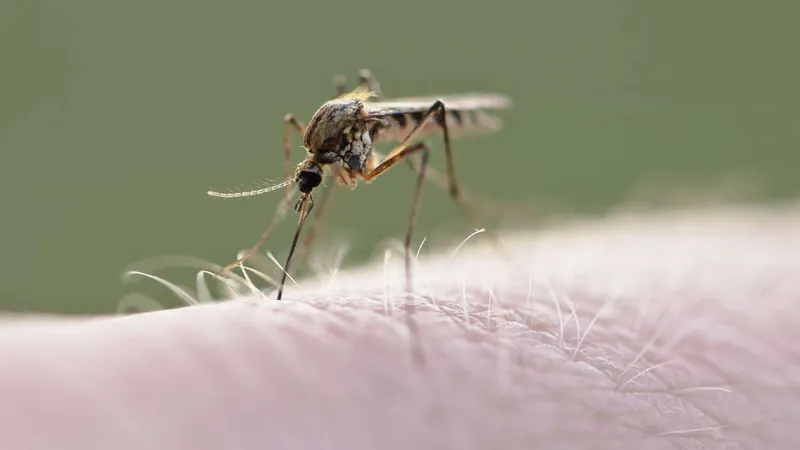
Legionnaire's Disease: From NYC to a Nationwide Threat as Climate Change Heats Up
2025-08-20
Author: Lok
Air conditioners are running non-stop this summer, cooling everything from small apartments to massive high-rises. But while these machines provide relief, they also create the perfect breeding ground for a deadly bacteria: Legionnaire's disease.
Currently wreaking havoc in New York City, this bacterial infection has already sickened over 100 individuals and claimed five lives in a concerning outbreak that shows no signs of slowing down. Though largely associated with the Northeast, the growing threat of Legionnaire's disease is on the radar of various urban areas across the United States.
A Climate-Driven Crisis
Climate change is transforming this once localized health issue into a potential national crisis. Areas in the Northeast and Midwest—where older infrastructure meets rising temperatures—are witnessing an alarming increase in Legionnaire's cases. Recently, Legionella bacteria were found in a nursing home's water system in Dearborn, Michigan, highlighting how quickly this health threat can spread beyond its historical boundaries.
Know the Risks: Who's Most Vulnerable?
Legionnaire's disease can infect anyone breathing in bacteria-laden water droplets. The symptoms—fever, headaches, and coughing—can quickly escalate into severe lung infections, with a mortality rate looming around 10%. The most at-risk individuals include young children, the elderly, pregnant people, and those with compromised immune systems. In the U.S., about 5,000 lives are lost to this illness annually, particularly affecting those in low-income housing where outdated cooling systems flourish.
The Intersection of Health and Inequality
This outbreak serves as a stark reminder of how climate change exacerbates the vulnerabilities faced by marginalized communities. Those living in areas prone to extreme weather often find themselves with inadequate infrastructure and compromised health, increasing their risk to infections like Legionnaire's disease.
Originally identified after an outbreak in Philadelphia in 1976, Legionella bacteria can typically be found in streams, lakes, and plumbing systems across the nation. Under normal conditions, they pose little threat, but stagnant warm waters in cooling systems create a haven for their multiplication.
Weather Conditions and Infrastructure Decay
Summertime has always facilitated the spread of Legionnaire's disease, but climate change is intensifying the risks. Warming temperatures and extreme humidity create the ideal environment for the bacteria to thrive. With reports of increased rainfall and deteriorating water quality, the conditions for Legionella growth are becoming commonplace.
The Environmental Protection Agency (EPA) indicates that every extreme weather event increases the bacteria's potential range, making routine maintenance of community water systems crucial. However, with inspections on the decline since previous outbreaks, many low-income areas remain particularly vulnerable.
Proactive Measures: Protect Yourself and Your Community
The threat of Legionnaire's disease looms large with its ability to silently invade public spaces through microscopic droplets. For at-risk individuals—especially seniors and those with preexisting conditions—staying informed about health warnings is essential. Follow public health alerts and consider high-quality water filters to safeguard yourself, particularly during outbreaks.
However, individual measures only go so far. The real change must happen at the communal level, with stringent regulations and regular inspections of water systems to prevent Legionella growth. New York City, for instance, saw inspections plunge dramatically—only 1,200 cooling towers were checked in the first half of 2025 compared to over 5,000 in 2017.
As climate change continues to escalate these public health challenges, the combined efforts of local authorities, landlords, and the community itself are vital in combating the spread of Legionnaire's disease. The time for action is now—because if not, we may see these outbreaks become not just seasonal, but a permanent fixture in our cities.




 Brasil (PT)
Brasil (PT)
 Canada (EN)
Canada (EN)
 Chile (ES)
Chile (ES)
 Česko (CS)
Česko (CS)
 대한민국 (KO)
대한민국 (KO)
 España (ES)
España (ES)
 France (FR)
France (FR)
 Hong Kong (EN)
Hong Kong (EN)
 Italia (IT)
Italia (IT)
 日本 (JA)
日本 (JA)
 Magyarország (HU)
Magyarország (HU)
 Norge (NO)
Norge (NO)
 Polska (PL)
Polska (PL)
 Schweiz (DE)
Schweiz (DE)
 Singapore (EN)
Singapore (EN)
 Sverige (SV)
Sverige (SV)
 Suomi (FI)
Suomi (FI)
 Türkiye (TR)
Türkiye (TR)
 الإمارات العربية المتحدة (AR)
الإمارات العربية المتحدة (AR)